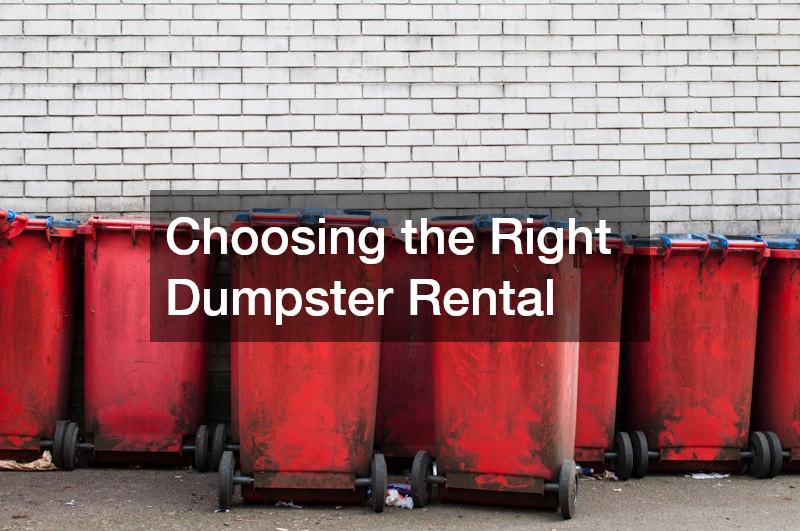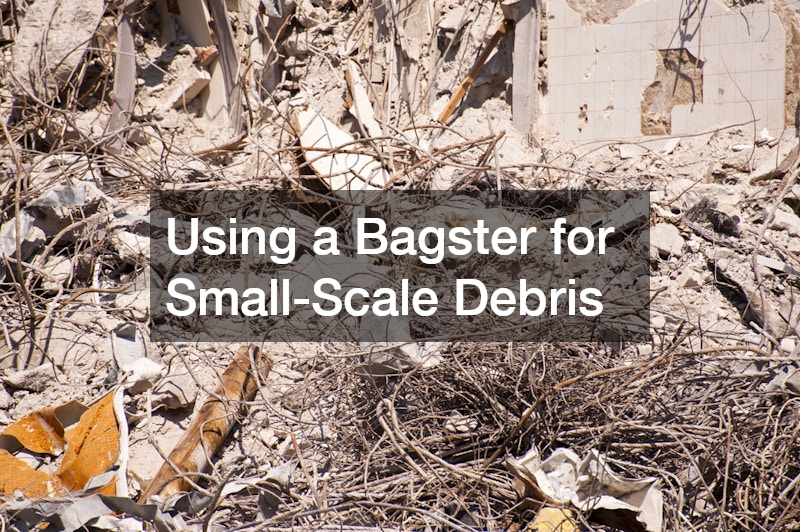Embarking on a remodeling project is an exciting venture that often transforms a space into something more functional, beautiful, and unique. However, alongside the excitement of redesigning and reimagining, there comes the responsibility of properly disposing of the waste generated during the process. Remodeling projects can quickly lead to large amounts of debris, old materials, and other items that need to be managed effectively. With the right disposal strategies in place, you can maintain a clean and efficient workspace while ensuring that materials are dealt with responsibly. Let’s explore some practical disposal solutions to consider for your next remodeling project.
Choosing the Right Dumpster Rental

When planning a remodeling project, one of the first decisions you’ll face is how to handle the waste generated. Dumpster rentals provide an easy and convenient solution for managing large amounts of debris. They come in various sizes to accommodate different project scales, making them ideal whether you’re tackling a full-home renovation or just a small remodel. Opting for a dumpster rental allows you to keep the space tidy throughout the project, without the constant back-and-forth trips to a landfill.
On a more specific level, it’s important to select the right size dumpster for your needs. Overestimating or underestimating the size could either leave you with too much empty space or force you to make multiple trips, costing more time and money. For example, if you’re working with a home remodeling service to renovate your kitchen, a smaller 10-yard dumpster may suffice for the demolition of old cabinets and countertops. However, a larger 20- or 30-yard dumpster might be required if you’re redoing several rooms or handling larger materials like drywall, flooring, or roofing.
Donating Usable Building Materials
In many cases, remodeling projects yield materials that, though no longer useful for their original purpose, could still be valuable to others. Donating usable building materials is an excellent way to reduce waste and support local charities or community projects. Items like gently used cabinets, fixtures, and appliances might be in great condition and can be repurposed in someone else’s home. Many organizations will accept these donations, offering you a way to dispose of materials responsibly while benefiting others at the same time.
Looking more specifically at this option, general contractors can be a helpful resource for determining which materials can be donated. For example, if you’re working with a contractor to remodel your living room and they are replacing old, functional cabinetry, you may be able to donate these items. Not only does this option help divert waste from landfills, but it also provides a tax deduction, making it an eco-friendly and cost-effective solution. Furthermore, if your contractor has established relationships with donation centers, they may even handle the transportation for you, streamlining the process.
Recycling Construction Waste Efficiently
Recycling is one of the most effective ways to manage waste during a remodeling project. It ensures that materials like wood, metal, concrete, and glass are repurposed rather than ending up in a landfill. With the increasing focus on sustainability, many cities and towns now provide specialized recycling programs for construction debris. These programs can help you reduce your carbon footprint and contribute to a circular economy, where materials are reused and recycled into new products.
On a more practical level, focusing on how to efficiently separate and recycle materials is key. Working with kitchen cabinet services can be particularly useful if you’re updating your kitchen, as many of the materials involved—such as wood, metal hardware, and countertops—can often be recycled. Some companies even have partnerships with recycling centers that specialize in reclaiming these materials, so they don’t go to waste. If you’re replacing old cabinets, countertops, or appliances, consider separating the materials before disposal. For instance, removing metal handles, knobs, or hinges from cabinets can increase the likelihood that the materials will be accepted for recycling.
Hiring a Professional Junk Removal Service

For some remodeling projects, especially those that involve significant demolition or the removal of bulky items, hiring a professional junk removal service can be one of the best disposal solutions. These services specialize in efficiently collecting and disposing of construction waste, household junk, and other large items that might be difficult to handle on your own. Professional junk removal companies not only provide the labor and equipment needed to clear out your space, but they also have the expertise to dispose of waste responsibly.
In particular, working with painting contractors during a remodeling project may result in substantial waste, such as old paint cans, brushes, or drop cloths. A junk removal service can be invaluable in clearing out the debris that painting often generates. These services can even help you dispose of hazardous materials like leftover paint, which must be handled carefully due to environmental concerns. Many junk removal companies have the capability to sort through and safely dispose of or recycle these materials.
Reducing Waste Through Smart Planning
A significant amount of remodeling waste can be avoided with proper planning from the start. By taking the time to think through your project and consider the types of materials you’ll need, the size of the demolition, and the amount of waste that will be generated, you can minimize the overall waste created. Smart planning not only helps ensure that you don’t over-purchase materials, which can end up being wasted, but also helps you think ahead about how to recycle, repurpose, or donate materials as you go along. This can greatly reduce the environmental footprint of your project and make disposal solutions more efficient.
For instance, if you’re planning a renovation that involves extensive flooring work, you may want to consult with biohazard cleanup services if there are any concerns about hazardous materials in the floor or subfloor. They can assist in safely removing potentially dangerous materials, such as mold or asbestos, and ensure the space is free from contaminants. By including these experts in the planning stages, you can better anticipate the types of materials you’ll need to dispose of safely and reduce unnecessary waste.
Repurposing Items for Future Use
Repurposing items during a remodel is an excellent way to save money and reduce waste, especially when you’re working with materials that still have value but no longer suit your current project. Rather than throwing away old furniture, fixtures, or building materials, consider ways to give them new life. Repurposing could mean converting old doors into unique tables, using leftover tiles for a new backsplash, or transforming scrap wood into custom shelving. This approach is not only environmentally friendly but also adds a personal touch to your remodel by keeping elements that tell a story or hold sentimental value.
For example, if you’re remodeling a living space and replacing old furniture or decor, you might find that some of these items can be repurposed into something functional. Mattress frames, for instance, can be upcycled into creative garden planters or storage solutions. Similarly, pieces of wood or metal from outdated furniture can be incorporated into your new design. This is especially valuable for projects that focus on sustainable living, as it cuts down on the need for new materials and minimizes waste, acting as one of the more eco-friendly disposal solutions.
Using a Bagster for Small-Scale Debris

For smaller remodeling projects, renting a Bagster might be the ideal solution for waste disposal. A Bagster is a large, durable bag that you can fill with debris from your project. It is a convenient and cost-effective option for homeowners who don’t need a full-sized dumpster but still need a reliable way to manage construction waste. Once filled, the Bagster is picked up by a local waste management service and taken to the appropriate disposal or recycling center. These disposal solutions are perfect for DIY projects or small remodels, allowing you to manage waste without the need for a large, bulky dumpster taking up space on your property.
If you’re working on an HVAC repair project, the Bagster can be a great choice for cleaning up leftover materials like old ductwork, insulation, or parts that need to be replaced. These smaller projects can still generate a surprising amount of waste, and having a Bagster on hand allows you to efficiently collect and dispose of it. Plus, since the Bagster is compact and easy to store, it won’t take up too much space while you’re working.
Coordinating Pickup With Local Services
Efficient disposal solutions don’t just happen by accident—they require careful coordination with local services to ensure materials are handled appropriately. Many communities have waste management and recycling programs that make it easier to dispose of remodeling debris, but these services often need to be scheduled in advance. Whether you’re dealing with large items, such as broken appliances, or smaller debris from demolition work, organizing pickup with local services ensures that everything is disposed of correctly and on time. Being proactive in scheduling these services will help keep your project on track and minimize the risk of debris piling up on your property.
If your remodeling project involves upgrading insulation or performing extensive attic insulation work, coordinating with local waste disposal services is essential for ensuring that materials like old insulation are safely and properly disposed of. Many insulation materials, especially older types, can be hazardous, and disposing of them through the appropriate channels is vital. Local services may offer special pickups for construction waste or hazardous materials like insulation, which ensures you don’t miss out on any eco-friendly solutions available in your area.
Separating Waste by Material Type
One of the most effective ways to manage disposal during a remodeling project is to separate waste by material type. Many types of waste, such as wood, metal, drywall, and concrete, can be recycled or reused, but only if they are properly sorted. By segregating materials at the outset, you can ensure that each material is disposed of in the most environmentally responsible way possible. This process not only makes recycling easier but also helps reduce the amount of waste sent to landfills, ultimately contributing to a more sustainable approach to remodeling.
For example, if you’re working with electrical contractors to upgrade wiring or install new fixtures, it’s important to set aside scrap metal and wire for recycling. Electrical components often contain valuable materials, like copper, which can be reclaimed and repurposed. Similarly, when remodeling a room and tearing out drywall, separating it from other debris like wood or flooring can help ensure that the drywall is disposed of in an eco-friendly way, as it can be recycled. By being proactive in sorting materials, you can save time and effort while reducing the environmental impact of your project, all while utilizing disposal solutions that are best suited for each type of waste.
Disposing of Hazardous Materials Safely

Certain materials used in remodeling projects are classified as hazardous and require special handling to ensure they are disposed of safely. These include asbestos, lead-based paint, certain types of insulation, and old appliances that contain harmful chemicals. If these materials are not disposed of properly, they can pose serious health risks to you, your family, and the environment. For this reason, it’s important to be aware of what constitutes hazardous waste during your remodeling project and plan accordingly to handle it correctly.
When dealing with hazardous materials, it is crucial to partner with professionals who specialize in the safe disposal of such items. For example, if your project involves epoxy floor coating, which often includes chemicals that can be harmful if mishandled, you may need to work with a licensed disposal service. Some companies that provide epoxy floor coating also offer safe removal and disposal of any leftover materials. They can ensure that these substances are handled in compliance with local regulations, preventing contamination and health hazards.
Remodeling projects can be both exciting and overwhelming, but by incorporating smart disposal solutions, you can manage waste efficiently and sustainably throughout the process. Whether it’s choosing the right dumpster rental, repurposing materials, or coordinating pickups with local services, there are many strategies that can help minimize your environmental impact while keeping your project on track. By focusing on responsible disposal and recycling practices, you not only ensure a cleaner worksite but also contribute to a more sustainable future. When handled with care, the waste generated by your remodeling project can be reduced, reused, and recycled, creating a positive impact that extends far beyond your home.
